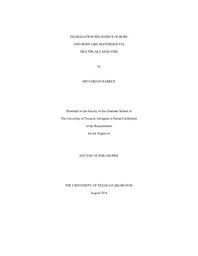
ATTENTION: The works hosted here are being migrated to a new repository that will consolidate resources, improve discoverability, and better show UTA's research impact on the global community. We will update authors as the migration progresses. Please see MavMatrix for more information.
Show simple item record
| dc.contributor.author | Sarker, Md Farzad | en_US |
| dc.date.accessioned | 2014-09-17T17:30:36Z | |
| dc.date.available | 2014-09-17T17:30:36Z | |
| dc.date.issued | 2014-09-17 | |
| dc.date.submitted | January 2014 | en_US |
| dc.identifier.other | DISS-12805 | en_US |
| dc.identifier.uri | http://hdl.handle.net/10106/24768 | |
| dc.description.abstract | Bone fracture is a common health risk for older people suffering from bone disease like osteoporosis. The more severe the osteoporosis is the more structural degradation in bones occurs, which eventually makes bones more fracture prone. The mechanical behavior of bone depends on the structural response of bone constituents over a broad range of length scales spanning from the nanoscale collagen fibril level to the macroscale trabeculae level. As such, in order to understand bone fracture, it is important to know the structure-property relations of bone material over the entire length of scale. Surprisingly, a quantitative understanding of bone fracture toughness is still not well understood, which the premise of the current study is. The multiscale analysis of bone is performed by considering five distinctive microstructures of bone, namely, the nano scale, submicron scale, micron scale, macro scale and trabecular bone itself. These substructures span almost over 9 order of length scales. By considering the nanoscale collagen fibril, the building block of bone composed of collagen protein (TC) and hydroxyapatite (HAP) mineral crystal, as a discontinuous fiber reinforced composite structure, the Halpin-Tsai relation for discontinuous fiber reinforced composites were used as the initial process for calculating mechanical properties of HAP and TC in nano scale. From the hierarchical level 2 to level 5, a self-similar approach was used to determine the mechanical properties of subsequent microstructures. Then, these properties were applied on several finite element models consisting of several fully three dimensional solid trabecular model (obtained from direct micro CT scan) and five different "approximated spongy" microstructures with appropriate boundary conditions. Each approximated model represents a simplified microstructure of the trabecular network. Critical stress intensity factor or fracture toughness was calculated from linear elastic fracture mechanics theories using the constitutive model developed from multi-scale analysis. The effects of trabecular thickness on Mode I fracture toughness were studied with different models of different thickness and their relations were analyzed. A comparative study of structural stiffness and anisotropy was conducted between the CT scan image based real bone microstructure and approximated simplified bone like microstructures. Finally, a 3D printing based manufacturing method was adopted to fabricate and characterize SiC nanoparticle reinforced nanocomposites using the micro CT image we studied. The stress-strain response was measured and deformation mechanism was studied. | en_US |
| dc.description.sponsorship | Adnan, Ashfaq | en_US |
| dc.language.iso | en | en_US |
| dc.publisher | Mechanical Engineering | en_US |
| dc.title | Degradation Mechanics Of Bone And Bone Like Materials Via Multiscale Analysis | en_US |
| dc.type | Ph.D. | en_US |
| dc.contributor.committeeChair | Adnan, Ashfaq | en_US |
| dc.degree.department | Mechanical Engineering | en_US |
| dc.degree.discipline | Mechanical Engineering | en_US |
| dc.degree.grantor | University of Texas at Arlington | en_US |
| dc.degree.level | doctoral | en_US |
| dc.degree.name | Ph.D. | en_US |
Files in this item
- Name:
- Sarker_uta_2502D_12805.pdf
- Size:
- 7.044Mb
- Format:
- PDF
This item appears in the following Collection(s)
Show simple item record


